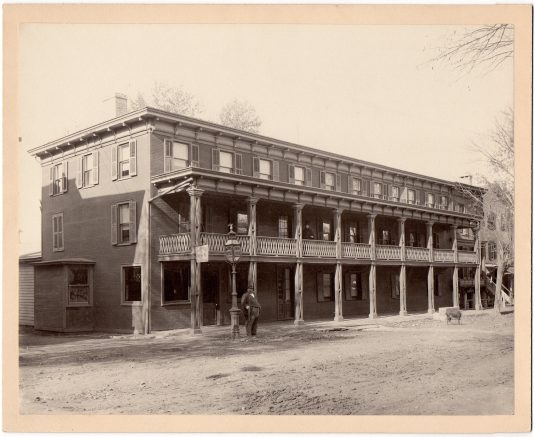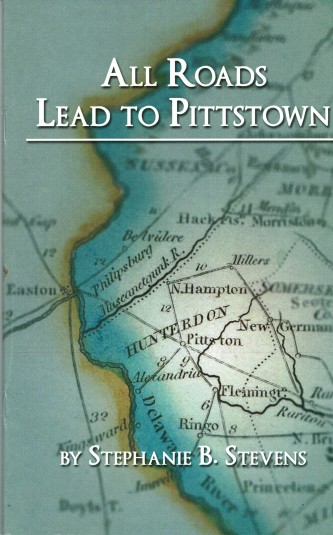
This is one of my favorite photographs.1 The building is Mount’s Hotel on Flemington’s Main Street, across from and a little north of the Union Hotel. It was replaced in the 1970s by the group of shops called ‘New Market,’ built by Don Shuman.

This is one of my favorite photographs.1 The building is Mount’s Hotel on Flemington’s Main Street, across from and a little north of the Union Hotel. It was replaced in the 1970s by the group of shops called ‘New Market,’ built by Don Shuman.
In her excellent book All Roads Lead to Pittstown (2015),1 Stephanie Stevens called attention to the early roads that converged on the village of Pittstown. Roads were certainly important, but just as important were creeks in creating the locations of Hunterdon villages.
Two Letters Written by Sen. John Lambert
Senator John Lambert of Amwell is one of Hunterdon’s most interesting historical figures.1 He served in the state legislature during the Revolution and afterwards served as Acting Governor before being elected to Congress and then to the U.S. Senate.
Recently, my son, Ben Zimmer, sent me a clipping that a friend of his had found in the Trenton True American for March 7, 1803. This friend, Barry Popik, was researching the expression “Uncle Sam,” (see “New Light on “Uncle Sam”), and had found an instance of its use in this letter to the editor:
My previous three articles concerned the history of the old Howell House on Worman Road, on the periphery of the Rosemont neighborhood. Today I move over to the southwest quadrant of the village, back to the part of Mount Amwell that John Reading kept for himself.
For anyone traveling north on Route 579 from the village of Ringoes in East Amwell, Hunterdon County, there is a landmark that will surely catch your eye, standing opposite the old Bel-Del railroad station. It is a three-story house that was once a showplace but has been deteriorating for at least 25 years. People like me who have been watching it all this time marvel that it is still standing.
This is part two of a series on some of the properties created in the Haddon Tract of Amwell Township, Hunterdon County.
Jacob Peter Sniter and Nicholas Sayn jointly purchased 1300 acres in Amwell Township from Elizabeth Haddon Estaugh in 1748. The two men sold off several lots and then divided the land remaining between them. Part One dealt with Nicholas Sayn/Sine, who acquired the southern half. This article deals with Jacob Peter Sniter who got the northern half.
Who really found the Delaware River boats in December 1776? the boats that Gen. Washington was supposed to rely on to carry his army across the river on Christmas Eve? For a long time I was certain it was David Johnes of Amwell, working with Daniel Bray and Jacob Gearhart. Now I’m not so sure. In fact, I now have serious doubts.
Camp Ground of the Glorious Old Continental Army in 1777
by Jonathan M. Hoppock
originally published in the Democrat-Advertiser, Oct. 10, 1901
From the photograph and from Hoppock’s description, it appears that this “campground” was located along Route 523 near Sand Brook.
 Better late than never. I’ve finally read Stephanie Stevens’ book All Roads Lead to Pittstown, published by the Hunterdon County Cultural and Heritage Commission. What a fascinating story she has to tell. I was dimly aware of Pittstown’s role in the Revolution, but what Stephanie has found adds enormously to our knowledge of the time. She managed to find references to Pittstown (specifically the mills of Moore Furman) in the letters of George Washington, the pension application of William Anderson, and the journal of James Parker, whose farm was located on Route 513 between Clinton and Pittstown.
Better late than never. I’ve finally read Stephanie Stevens’ book All Roads Lead to Pittstown, published by the Hunterdon County Cultural and Heritage Commission. What a fascinating story she has to tell. I was dimly aware of Pittstown’s role in the Revolution, but what Stephanie has found adds enormously to our knowledge of the time. She managed to find references to Pittstown (specifically the mills of Moore Furman) in the letters of George Washington, the pension application of William Anderson, and the journal of James Parker, whose farm was located on Route 513 between Clinton and Pittstown.